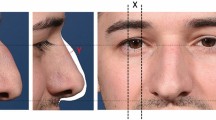Abstract
Background
In Western countries, dorsal hump reduction surgery is prevalent due to the nasal profiles of the patients admitted for esthetic rhinoplasty operations. There are numerous techniques for hump reduction. Currently, dorsal hump reduction techniques that allow the dorsum to be preserved are highly popular.
Objectives
In the present research, the author describes several approaches for the let-down technique. These approaches are aimed at selecting the appropriate technique based on the patients’ needs.
Methods
The patients with nasal hump deformities who had undergone operations were investigated. Fifty-one patients met the inclusion criteria and their records were assessed. All patients who were included in the study were assessed with the Rhinoplasty Outcome Evaluation (ROE) questionnaire at their one-year follow-up appointment. In the present study, six approaches were performed by the surgeon for the let-down technique.
Results
The ROE scores before and after 1 year of surgery were compared. The median of the ROE score before surgery was 65.2. The median score was 90.2 points 1 year after surgery. The ROE score significantly increased before and after surgery (p < 0.001). The patient satisfaction was found to be excellent in 92% of the included patients. There were no complications, and there was no need for revision surgery.
Conclusion
These new approaches for the let-down technique will allow better short- and long-term cosmetic and functional outcomes and will enable surgeons to choose the best option for patients who are candidates for the let-down technique. Preoperative imaging of patients with nasal humps will also provide several advantages for both the surgeon and the patients.
Level of Evidence IV
This journal requires that authors assign a level of evidence to each article. For a full description of these Evidence-Based Medicine ratings, please refer to the Table of Contents or the online Instructions to Authors www.springer.com/00266.














Similar content being viewed by others
References
Abdelwahab MA, Neves CA, Patel PN, Most SP (2018) Cosmetic surgery National Data Bank statistics. Aesthet Surg J 38:1–24. https://doi.org/10.1093/asj/sjy132
Saban Y, Daniel RK, Polselli R et al (2018) Dorsal preservation: the push down technique reassessed. Aesthet Surg J 38:117–131. https://doi.org/10.1093/asj/sjx180
Barrett DM, Casanueva F, Wang T (2017) Understanding approaches to the dorsal hump. Facial Plast Surg 33:125–132. https://doi.org/10.1055/s-0037-1598033
Abdelwahab MA, Neves CA, Patel PN, Most SP (2020) Impact of dorsal preservation rhinoplasty versus dorsal hump resection on the internal nasal valve: a quantitative radiological study. Aesthet Plast Surg. https://doi.org/10.1007/s00266-020-01627-z
Rohrich RJ, Muzaffar AR, Janis JE (2004) Component dorsal hump reduction: the importance of maintaining dorsal aesthetic lines in rhinoplasty. Plast Reconstr Surg 114:1298–1308. https://doi.org/10.1097/01.PRS.0000135861.45986.CF
Öztürk G (2020) Push-down technique without osteotomy: a new approach. Aesthet Plast Surg. https://doi.org/10.1007/s00266-020-01660-y
Öztürk G (2020) A novel hump reinsertion technique to reconstruct the nasal dorsum. J Craniofac Surg. https://doi.org/10.1097/SCS.0000000000006262
Tuncel U, Aydogdu O (2019) The probable reasons of dorsal hump problems following let-down/push-down rhinoplasty and solution proposals. Plast Reconstr Surg. https://doi.org/10.1097/PRS.0000000000005909
Cottle MH (1954) Nasal roof repair and hump removal. AMA Arch Otolaryngol 60:408–414. https://doi.org/10.1001/archotol.1954.00720010420002
Cottle MH, Loring RM (1946) Corrective surgery of the external nasal pyramid and the nasal septum for restoration of normal physiology. Ill Med J 90:119–135
Drumheller GW (1995) The cottle push down operation. Am J Cosmet Surg 12:255–261. https://doi.org/10.1177/074880689501200307
Huizing EH (1975) Push down of the external nasal pyramid by resection of wedges. Rhinology 13:185–190
Jobe R (1981) En bloc nasal shift rhinoplasty: an approach to the small crooked nose. Ann Plast Surg 7:120–125. https://doi.org/10.1097/00000637-198108000-00007
Neves Pinto RM (1997) On the “let-down” procedure in septorhinoplasty. Rhinology 35:178–180
Tanna N, Nguyen KT, Ghavami A et al (2018) Evidence-based medicine: current practices in rhinoplasty. Plast Reconstr Surg. https://doi.org/10.1097/PRS.0000000000003977
Kim J, Kim CH, Oh JH et al (2020) Saddle deformity after septoplasty and immediate correction. J Craniofac Surg. https://doi.org/10.1097/SCS.0000000000005898
Montes-Bracchini JJ (2019) Nasal profile hump reduction using the let-down technique. Facial Plast Surg 35:486–491. https://doi.org/10.1055/s-0039-1695751
Goksel A, Saban Y (2019) Open piezo preservation rhinoplasty: a case report of the new rhinoplasty approach. Facial Plast Surg
Taş S (2020) The alignment of the nose in rhinoplasty: fix down concept. Plast Reconstr Surg 145:378–389. https://doi.org/10.1097/PRS.0000000000006523
Taş S (2019) Dorsal roof technique for dorsum preservation in rhinoplasty. Aesthet Surg J. https://doi.org/10.1093/asj/sjz063
Öztürk G (2020) Improvement of alar concavity with scroll ligament preservation: sandwich technique. Aesthet Surg J. https://doi.org/10.1093/asj/sjaa018
Funding
There is no funding to report.
Author information
Authors and Affiliations
Corresponding author
Ethics declarations
Conflict of interest
The author has no conflict of interest to declare.
Ethical Standards
This study was performed according to the standards for biomedical research on human subjects set by the Declaration of Helsinki.
Informed Consent
Informed consent was obtained from all patients.
Additional information
Publisher's Note
Springer Nature remains neutral with regard to jurisdictional claims in published maps and institutional affiliations.
Electronic supplementary material
Below is the link to the electronic supplementary material.
Supplementary material 1 (MP4 214068 kb)
Rights and permissions
About this article
Cite this article
Öztürk, G. New Approaches for the Let-Down Technique. Aesth Plast Surg 44, 1725–1736 (2020). https://doi.org/10.1007/s00266-020-01801-3
Received:
Accepted:
Published:
Issue Date:
DOI: https://doi.org/10.1007/s00266-020-01801-3




